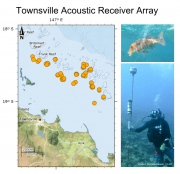NERP TE Project 6.1 - Maximising the benefits of mobile predators to GBR ecosystems: the importance of movement, habitat and environment (AIMS)
Project summary
This project will determine the movement and habitat use of large predatory fishes such as sharks and coral trout in reef and coastal environments of the Great Barrier Reef. Individual fish are fitted with acoustic transmitters that are detected by an array of acoustic monitoring stations. These monitoring stations record the presence and movement of fish between the coast and the reef, and between reefs. Predator presence and movement will be integrated with habitat mapping and environmental monitoring data to identify factors that lead to changes in movement patterns and to define any preferred locations or conditions that can be targeted for conservation or management.
Why this research is needed
Results of this research will inform managers about residency patterns of predatory fish, their movements between and preferences for various habitat types, and how these are related to the zones of the Great Barrier Reef Marine Park. This information is critical for balancing the competing demands of fisheries and ecosystem sustainability.
Research-user focus
The project will support the conservation and management of mobile predators by federal and state government bodies including the Great Barrier Reef Marine Park Authority (GBRMPA), the Department of Sustainability, Environment, Water, Population and Communities, the Department of Agriculture, Fisheries and Forestry, and the Queensland Seafood Industry Association.
Outcomes
- Greater understanding of habitat use and the extent of movement of mobile predator species in coastal and reef ecosystems.
- Greater understanding of the factors that lead to changes in the residency and movement of mobile predators, such as habitat, developmental stage and environmental conditions.
- A more comprehensive understanding of the scale of daily and seasonal movements of marine predators in relation to marine park zoning and the efficacy of zones in providing protection to mobile predators.
Reports, Publications and News
For more information see Project 6.1 'Maximising the benefits of mobile predators to Great Barrier Reef ecosystems: the importance of movement, habitat and environment' on the NERP Tropical Ecosystems Hub site.
Images
Datasets

There are 3 datasets:
1. Acoustic array - this dataset includes a description of the acoustic array deployed on reefs offshore from Townsville. The array was in place from August 2011 to December 2014.
2. Individuals tagged - this dataset includes a description of the individuals fitted with acoustic transmitters for tracking on an acoustic array deployed on reefs offshore from Townsville.
Presence information for sharks and fish fitted with acoustic transmitters on reefs in the Townsville region. Acoustic receivers are deployed on: Bramble (4), Rib (4), Kelso (2), John Brewer (4), Lodestone (4), Helix (4), Keeper (2), Glow (3), Cotton Shoal (1), Arc (1), Grub (4), Yankee (3), Centipede (2), Wheeler (5), Davies (2), Pinnacle (1) and Little Broadhurst (2) reefs. Transmitter life ranges from 12-30 months. Transmitters report depth data to indicate position of the animal in the water column.
This project will determine the movement and habitat use of large predatory fishes such as sharks and coral trout in reef and coastal environments of the Great Barrier Reef. This project will employ acoustic monitoring technology in a series of inshore and offshore environments including coastal bays, inshore reefs and offshore reefs to monitor the presence and movements of predator species (elasmobranchs and teleosts).






